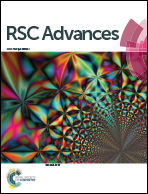Butane detection: W-doped TiO2 nanoparticles for a butane gas sensor with high sensitivity and fast response/recovery†
Abstract
This article describes a new option for butane detection: W-doped TiO2 nanoparticles with high sensitivity and fast response/recovery toward butane, which were obtained from a simple, non-aqueous sol–gel route. The structure, morphology, surface chemical state and specific surface area were analyzed by X-ray powder diffraction (XRD), transmission electron microscopy (TEM), X-ray photoelectron spectrum (XPS) and N2-sorption isotherm, respectively. The obtained products are anatase-type TiO2 with a small grain size (7.5 ± 1.4 nm) and a high specific surface area (181.15 m2 g−1). Tungsten element presents in the +6 oxidation state. The resistance–temperature measurements indicate that tungsten dopant leads to the decrease in resistance. The as-prepared pure and W-doped TiO2 nanoparticles were used to fabricate gas sensor devices. Gas response toward 3000 ppm butane is increased from 6 to 17.8 through the doping of 5% tungsten. Meanwhile, the response and recovery time toward 3000 ppm butane are as fast as 2 and 12 s, respectively. Moreover, the sensor also possesses low detection limit, good linear dependence, good repeatability and long-term stability, indicating the potential of using W-doped TiO2 nanoparticles for butane gas detection. In addition, a possible mechanism for the enhanced sensitivity of W-doped TiO2 nanoparticles toward butane is also offered.


 Please wait while we load your content...
Please wait while we load your content...